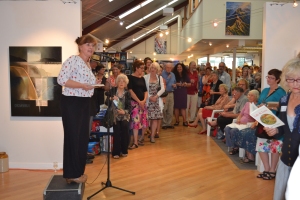A Facebook friend has recently posted a beautiful update about a breadboard. He’s writing with great candour about a recent cancer diagnosis and heading towards chemotherapy. Because he is a writer, he is expressing his present pain, both physical and spiritual, most eloquently. His post has inspired me to write about, not a breadboard, but a colander, a mixing bowl, two tablecloths and a wedding ring.

The colander, a beaten aluminum, was my mother’s. When I wash fruit, or rinse salad leaves, I am reminded of her. It’s just another household object, tossed into a very disorganised drawer of mismatched pots. But this colander, carries the memory of a coal range, a small green fridge and a time when salads were chopped, like ribbons of crepe paper. When salads were an art form in a leaf shaped piece of Carlton Ware. Hard boiled eggs were halved and placed on the outer edge, carrot was grated atop, radishes, and tomatoes for a splash of colour. I think I can smell a whiff of mint that grew by the grace of the dripping outside tap. And the pièces de résistance would be the Highlander mayonnaise dressing – in a separate equally beautiful, possibly Carlton Ware jug. There would be the hot summer sun from the open back door, competing with the fire of the Shacklock. A delicate balance of opening and closing doors while the new potatoes boiled, regulating the temperature. A crochet cloth would be thrown over the beautifully set table to keep the flies at bay.

Uncle’s Gripstand mixing bowl (that might well have been my grandmothers)
Then, there is my uncle’s mixing bowl. I’ve spoken of this before. I use it once a year to make my Christmas cake, my mother’s recipe. It brings back memories of my favourite bachelor uncle, who taught me to swim. His bowl sits on the top shelf above the pantry and whenever I see it in passing, I am reminded of him. It has a small chip now which I ignore. I was swimming in the Golden Bay in the late afternoon when word came that he had died. I had decided to go swimming on a whim, just prior to having guests for dinner.
Two days before Christmas, our youngest son got married in our garden. We’ve lived in our house for thirty years. The old house groaned with the pleasure. Every door was open to the outdoors and the garden chose to sparkle. Listening to the wedding video, as the couple make their vows, unnoticed at the time, we can hear the birds chirping agreement. The house whispered loving secrets too, reminding us of wild teenage parties, old loves, new loves, friendships too. We all loved anew.
I found an old white tablecloth that I had purchased when I first left home and moved to Wellington. I was in a post office hostel and the Irish Linen man called. Back then I was in love with a faithless sailor. But the tablecloth survived. My mother’s old white tablecloth, now a little worse for wear, but good quality linen was retrieved from obscurity – the one that came out every Christmas during my childhood. A wedding loves a white tablecloth, but even more the mother of the groom loved the history of the two white tablecloths. When regaling my sons briefly with their history, the guffaws at the thought of a glory box sometimes known as a hope chest, overshadowed my romantic notions.
I’m posting a photo of the wedding cake, because it too is filled with precious ingredients. My granddaughter, my new daughter-in-law and I, made the cupcakes together. We had a batch failure which threw us into disarray. An over-beating of the mixture. We started again – three batches in all, and as happens when love is in the air, a friend of the groom, with a flair for decorating, iced the cakes for us.

And then we have the bride’s wedding ring. From family rings, a new and modern ring was fashioned at short notice, by a local jeweller. It is beautiful, contemporary and a melding of family history. The groom too wears a family ring. Thehappy couple have left New Zealand leaving us with memories and carrying these physical objects that represent both their love and ours. Together they are growing their love and our next grandchild.











